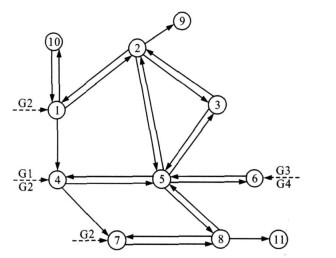Cellular automata model of urban traffic emergency evacuation and rescue
-
摘要: 分析了城市内部各向车流冲突造成的车辆延误对疏散与救援决策的影响, 将交叉口控制参数引入到现有的基于元胞传输模型的应急疏散救援仿真模型中, 建立灾时交叉口紧急控制下的应急疏散救援仿真模型。改进后的模型以规划周期内疏散与救援加权行程时间最小为目标, 并引入反流策略。仿真结果表明: 由于低优先级的车流G1和G2让行高优先级车流G3和G4而产生延误, 其平均行程时间分别增加了10.0、11.1 s, 符合城市内部疏散与救援的实际情况; 反流策略实施后, 受益的车流G2和G4行程时间分别下降了6.5、6.0 s。可见, 提出的模型及反流策略有效。Abstract: The effects of vehicle delay on the emergency evacuation and rescue decision-making of all traffic flow conflicts within cities were analyzed.An intersection control parameter was introduced into the exciting simulation model of emergency evacuation and rescue, and the model was based on cell transmission model.A simulation model of emergency evacuation and rescue was built under intersection emergency control.In the improved model, the weighted travel time of emergency evacuation and rescue in planning horizon was minimized, and contraflow strategy was introduced.Simulation result shows that because giving way to high-priority traffic flows G3 and G4, the average travel times of low-priority traffic flows G1 and G2 increase by 10.0 s and 11.1 s respectively, which accords with the actual circumstance of urban emergency evacuation and rescue.After the implementation of contraflow strategy, the travel times of beneficial traffic flows G2 and G4 decrease by 6.5 s and 6.0 s respectively.So the model and contraflow strategy are feasible.
-
表 1 G1组最优解
Table 1. Optimal solution of G1

表 2 G2组最优解
Table 2. Optimal solution of G2

表 3 G3组最优解
Table 3. Optimal solution of G3

表 4 G4组最优解
Table 4. Optimal solution of G4

表 5 理想行程时间
Table 5. Ideal travel times

表 6 实际行程时间对比
Table 6. Comparison of real travel times

-
[1] ZILIASKOPOULOS A K. A linear programming model for the single destination system optimum dynamic traffic assignment problem[J]. Transportation Science, 2000, 34(1): 37-49. doi: 10.1287/trsc.34.1.37.12281 [2] WALLER S T, ZILIASKOPOULOS A K. A chanceconstrained based stochastic dynamic traffic assignment model: analysis, formulation and solution algorithms[J]. Transportation Research Part C: Emerging Technologies, 2006, 14(6): 418-427. doi: 10.1016/j.trc.2006.11.002 [3] NG M W, WALLER S T. Reliable evacuation planning via demand inflation and supply deflation[J]. Transportation Research Part E: Logistics and Transportation Review, 2010, 46(6): 1086-1094. doi: 10.1016/j.tre.2010.04.001 [4] CHIU Y C, ZHENG Hong. Real-time mobilization decisions for multi-priority emergency response resources and evacuation groups: model formulation and solution[J]. Transportation Research Part E: Logistics and Transportation Review, 2007, 43(6): 710-736. doi: 10.1016/j.tre.2006.11.006 [5] KIM S, SHEKHAR S, MIN M. Contraflow transportation network reconfiguration for evacuation route planning[J]. IEEE Transactions on Knowledge and Data Engineering, 2008, 20(8): 1115-1129. doi: 10.1109/TKDE.2007.190722 [6] XIEC, LIN D Y, WALLER S T. A dynamic evacuation network optimization problem with lane reversal and crossing elimination strategies[J]. Transportation Research Part E: Logistics and Transportation Review, 2010, 46(3): 295-316. doi: 10.1016/j.tre.2009.11.004 [7] HAMZA-LUP G L, HUA K A, PENG Rui. Leveraging e-transportation in real-time traffic evacuation management[J]. Electronic Commerce Research and Applications, 2007, 6(4): 413-424. doi: 10.1016/j.elerap.2006.12.002 [8] 邹亮, 任爱珠, 张新. 基于GIS的灾害疏散模拟及救援调度[J]. 自然灾害学报, 2006, 15(6): 141-145. doi: 10.3969/j.issn.1004-4574.2006.06.025ZOU Liang, REN Ai-zhu, ZHANG Xin. GIS-based evacuation simulation and rescue dispatch in disaster[J]. Journal of Natural Disasters, 2006, 15(6): 141-145. (in Chinese) doi: 10.3969/j.issn.1004-4574.2006.06.025 [9] MENG Q, KHOO H L, CHEU R L. Microscopic traffic simulation model-based optimization approach for the contraflow lane configuration problem[J]. Journal of Transportation Engineering, 2008, 134(1): 41-49. doi: 10.1061/(ASCE)0733-947X(2008)134:1(41) [10] DAGANZO C F. The cell transmission model, part Ⅱ: network traffic[J]. Transportation Research Part B: Methodological, 1995, 29(2): 79-93. doi: 10.1016/0191-2615(94)00022-R [11] 靳文舟, 张杰, 梅冬芳. 基于细胞自动机模型的交通流模拟程序[J]. 华南理工大学学报: 自然科学版, 2003, 31(5): 34-38. https://www.cnki.com.cn/Article/CJFDTOTAL-HNLG200305006.htmJIN Wen-zhou, ZHANG Jie, MEI Dong-fang. Traffic simulation program based on cellular automata model[J]. Journal of South China University of Technology: Natural Science Edition, 2003, 31(5): 34-38. (in Chinese) https://www.cnki.com.cn/Article/CJFDTOTAL-HNLG200305006.htm [12] SO S K, DAGANZO C F. Managing evacuation routes[J]. Transportation Research Part B: Methodological, 2010, 44(4): 514-520. [13] 龙建成, 高自友, 任华玲. 城市网络交通动态信号控制方法[J]. 中国公路学报, 2009, 22(4): 108-114, 121. https://www.cnki.com.cn/Article/CJFDTOTAL-ZGGL200904019.htmLONG Jian-cheng, GAO Zi-you, REN Hua-ling. Dynamic signal control method of urban network traffic[J]. China Journal of Highway and Transport, 2009, 22(4): 108-114, 121. (in Chinese) https://www.cnki.com.cn/Article/CJFDTOTAL-ZGGL200904019.htm [14] 安实, 崔建勋, 王健. 国外道路交通应急区域疏散研究综述[J]. 交通运输系统工程与信息, 2008, 8(6): 38-45. https://www.cnki.com.cn/Article/CJFDTOTAL-YSXT200806006.htmAN Shi, CUI Jian-xun, WANG Jian. An international review of road emergency transport and evacuation[J]. Journal of Transportation Systems Engineering and Information Technology, 2008, 8(6): 38-45. (in Chinese) https://www.cnki.com.cn/Article/CJFDTOTAL-YSXT200806006.htm [15] TUYDES H. Network traffic management under disaster conditions[D]. Chicago: Northwestern University, 2005. [16] LO H K. A cell-based traffic control formulation: strategies and benefits of dynamic timing plans[J]. Transportation Science, 2001, 35(2): 148-164. -





 下载:
下载:




